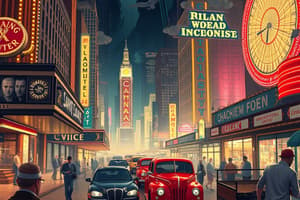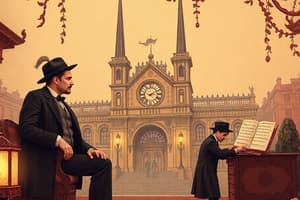Podcast
Questions and Answers
How did manufacturers' conversion to war material production impact their financial status during the Roaring 20s?
How did manufacturers' conversion to war material production impact their financial status during the Roaring 20s?
- Most manufacturers maintained their pre-war financial status without significant gains or losses.
- Manufacturers experienced a moderate increase in wealth due to government contracts.
- Manufacturers who did very well by converting to producing war material became very rich. (correct)
- Many manufacturers struggled financially due to the high costs of converting to war material.
What was one of the key factors that led to the increased demand for non-essential consumer goods during the Roaring 20s?
What was one of the key factors that led to the increased demand for non-essential consumer goods during the Roaring 20s?
- Relaxed trade regulations increased the availability of imported luxury items.
- Decreased manufacturing costs, making consumer goods more accessible.
- Government subsidies encouraged consumers to purchase more goods.
- Wealth created by war led to huge demand for non-essential consumer goods (correct)
How did the end of World War I affect the availability of jobs for women in America?
How did the end of World War I affect the availability of jobs for women in America?
- Men returning from war expected women to vacate jobs causing fewer jobs available to women. (correct)
- The government provided incentives that encouraged companies to hire more women than men.
- The number of jobs traditionally held by women steadily decreased.
- The war created new jobs for women and provided lasting gender equality in the workplace.
How did urbanization impact family structures and living situations during the Roaring 1920s?
How did urbanization impact family structures and living situations during the Roaring 1920s?
What was the primary goal of the 18th Amendment (Prohibition)?
What was the primary goal of the 18th Amendment (Prohibition)?
What was the intended impact of Prohibition on crime and corruption?
What was the intended impact of Prohibition on crime and corruption?
What was one societal change associated with flappers in the 1920s?
What was one societal change associated with flappers in the 1920s?
What was a key characteristic of flapper fashion in the 1920s?
What was a key characteristic of flapper fashion in the 1920s?
What did the Seneca Falls Convention demand regarding equality for women?
What did the Seneca Falls Convention demand regarding equality for women?
What was the impact of the 19th Amendment on women's roles in society?
What was the impact of the 19th Amendment on women's roles in society?
What was the main impact of the Great Migration on the Harlem Renaissance?
What was the main impact of the Great Migration on the Harlem Renaissance?
In what primary area did advertising shift as a result of women's increased income during the Roaring Twenties?
In what primary area did advertising shift as a result of women's increased income during the Roaring Twenties?
Which advertising appeal is best exemplified by West Electric’s slogan, 'Why there are over 50 million hair curlers in daily use'?
Which advertising appeal is best exemplified by West Electric’s slogan, 'Why there are over 50 million hair curlers in daily use'?
How did the film 'Birth of a Nation' contribute to the revival of Ku Klux Klan in the early 20th century?
How did the film 'Birth of a Nation' contribute to the revival of Ku Klux Klan in the early 20th century?
What groups did the Ku Klux Klan broaden their intolerance to in the 1920s, besides Blacks?
What groups did the Ku Klux Klan broaden their intolerance to in the 1920s, besides Blacks?
What impact did the First World War have on women's participation in the workforce?
What impact did the First World War have on women's participation in the workforce?
What genre of music gained popularity in the 1920s?
What genre of music gained popularity in the 1920s?
Between what years did Jazz as an art form develop?
Between what years did Jazz as an art form develop?
When was the 19th Amendment signed into law?
When was the 19th Amendment signed into law?
What did WW1 lead to?
What did WW1 lead to?
Flashcards
Interwar Years
Interwar Years
The period between World War I and World War II, including the Roaring 20s and the Great Depression.
Roaring 20s
Roaring 20s
A period of economic prosperity and cultural flourishing in the United States during the 1920s.
18th Amendment (Prohibition)
18th Amendment (Prohibition)
A constitutional amendment that prohibited the manufacture, sale, and transportation of alcohol.
19th Amendment (Woman Suffrage)
19th Amendment (Woman Suffrage)
Signup and view all the flashcards
Harlem Renaissance
Harlem Renaissance
Signup and view all the flashcards
Age of Jazz
Age of Jazz
Signup and view all the flashcards
Revival of Ku Klux Klan
Revival of Ku Klux Klan
Signup and view all the flashcards
Bandwagon Appeal
Bandwagon Appeal
Signup and view all the flashcards
Fear Appeal (Advertising)
Fear Appeal (Advertising)
Signup and view all the flashcards
Study Notes
- The Interwar Years are marked by the Roaring 20s and the Great Depression.
1920s
- The Roaring 20s was a period of significant social and economic change in the United States.
Roaring 20s USA
- Manufacturers became wealthy by converting to producing war materials.
- Wealth from the war created demand for non-essential consumer goods like radios, cars, and telephones.
- Infrastructure improved with better roads, telephone lines, and radio towers.
- There was a second wave of urbanization as families moved from farms to cities for industrial jobs.
- World War I deprivation led many to seek joy at any cost.
- The excesses of the Roaring 20s led to a renewal of the Temperance Movement.
18th Amendment: Prohibition
- The 18th Amendment, also known as Prohibition, forbade the manufacture, sale, and transportation of alcohol.
- It was intended to reduce crime, corruption, and what was considered loose morals.
- Prohibition was also meant to reduce the burden on the state, as it was thought the number of poor people would decline.
Universal Suffrage (19th Amendment)
- Women like Elizabeth Cady Stanton, Lucretia Mott, and Susan B. Anthony agitated for change, advocating for women's rights.
- The Seneca Falls Convention in 1848 drafted the "Declaration of Sentiments," demanding equality with men under the law. This included education, voting, equal pay, and the right to own property.
- Case Minor vs. Happersett (1875) argued for universal suffrage under the 14th amendment.
- August 18th, 1920 the 19th Amendment was signed into law which stated the right to vote cannot be denied based on sex.
- Impacts were seen over time and led to improvements in education, more gender equality, and greater spending on social welfare.
- The Sheppard-Towner Act (1921) was the first social welfare program that funded prenatal care and health.
Women's Changing Role
- 13,000 American women enlisted in the war, receiving the same pay and treatment as men upon their return.
- As men returned, women were expected to leave their jobs.
- Opportunities developed in textile mills, as typists, stenographers, and filing clerks.
- Women's income led to changes in advertising, promoting non-essential items.
Flappers
- Independence gained during wartime, combined with the 19th Amendment, led to social changes for women.
- Young women who became "Flappers" were free-spirited and independent.
- Flappers were known for shorter dresses, high heels, and makeup.
- Flappers stopped wearing corsets and wore shorter, more tomboyish hairstyles.
Advertising Appeals
- Bandwagon - West Electric used the phrase "Why there are over 50 million hair curlers in daily use."
- Fear - Listerine created the illness "halitosis" (bad breath).
- Less-than-perfect - Palmolive asked "Would your husband marry you again?"
- Real Man/Woman- Lion hats used the line "The right hat for real men."
- Testimonial – Stars like Miss Phyllis Haver "demand genuine Maybelline.”
- False advertising - La Mar promised to "Wash away fat."
Harlem Renaissance
- The Great Migration from 1916-1970 involved about 6 million Black people moving from Southern states to the North due to lack of opportunity and discrimination (including Jim Crow Laws).
- The Harlem Renaissance began in Harlem, New York.
- Artistic talent exploded in cities like Harlem, Cleveland, and L.A.
- This included all art forms; music, painting, poetry, and dance.
Age of Jazz
- Between 1895 and 1917, Jazz developed as an art form with artists like Buddy Bolden, Nick LaRocca, and Ferdinand "Jelly Roll" Morton.
- Jazz gained popularity in the 1920s.
- In 1925, Louis Armstrong and Duke Ellington recorded their first albums.
- The Charleston dance became popular in Jazz clubs, deviating from Ballroom dance.
- "The Jazz Singer" was the first full-length talking movie or "talkie" in 1927.
Revival of Ku Klux Klan
- The KKK was first established in 1866, but the film "Birth of a Nation"(1915) portrayed them as heroes, leading to their revival.
- "Birth of a Nation" was the first movie to be screened in the White House.
- Intolerance broadened towards not only Blacks but also Catholics, Jewish people, and immigrants.
- The KKK gained broad support in the 1920s.
- KKK members were used to gain political positions through a strategy where each member got 10 people to vote for a candidate.
- In some states, elected officials enough to dominate policy decisions.
Studying That Suits You
Use AI to generate personalized quizzes and flashcards to suit your learning preferences.




